warning lights Lancia Delta 2012 Owner handbook (in English)
[x] Cancel search | Manufacturer: LANCIA, Model Year: 2012, Model line: Delta, Model: Lancia Delta 2012Pages: 295, PDF Size: 8.29 MB
Page 96 of 295
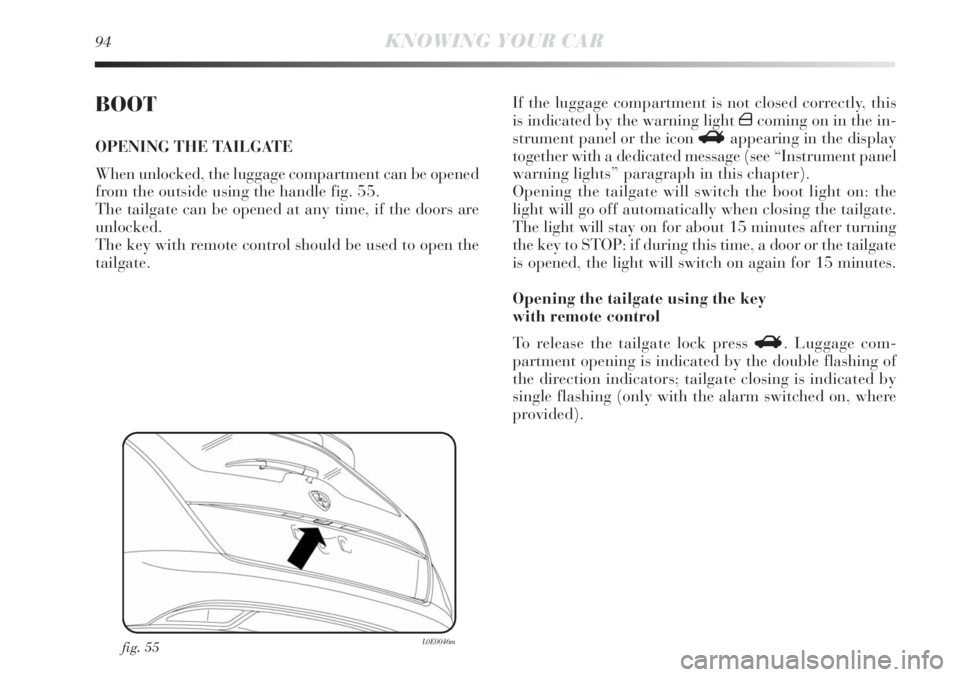
94KNOWING YOUR CAR
BOOT
OPENING THE TAILGATE
When unlocked, the luggage compartment can be opened
from the outside using the handle fig. 55.
The tailgate can be opened at any time, if the doors are
unlocked.
The key with remote control should be used to open the
tailgate.
fig. 55L0E0046m
If the luggage compartment is not closed correctly, this
is indicated by the warning light
´coming on in the in-
strument panel or the icon
Rappearing in the display
together with a dedicated message (see “Instrument panel
warning lights” paragraph in this chapter).
Opening the tailgate will switch the boot light on: the
light will go off automatically when closing the tailgate.
The light will stay on for about 15 minutes after turning
the key to STOP: if during this time, a door or the tailgate
is opened, the light will switch on again for 15 minutes.
Opening the tailgate using the key
with remote control
To release the tailgate lock press R. Luggage com-
partment opening is indicated by the double flashing of
the direction indicators; tailgate closing is indicated by
single flashing (only with the alarm switched on, where
provided).
Page 106 of 295

104KNOWING YOUR CAR
ADJUSTING THE HEADLIGHTS WHEN ABROAD
Dipped headlights are adjusted to drive in the country
where the vehicle was originally purchased. When trav-
elling in countries with opposite driving direction, to
avoid blinding the drivers on the other side of the road,
you need to cover the headlight areas depending on the
Highway code of the country you are travelling in.
ADAPTIVE LIGHTS (AFS – Adaptive Xenon Light)
This is a system combined with Xenon headlamps which
directs the main light beam and continuously and auto-
matically adapts it to the driving conditions round
bends/when cornering. The system directs the light beam
to light up the road in the best way, taking into account
the speed of the vehicle, the bend/corner angle and the
speed of steering.Activating/deactivating the system fig. 65
The adaptive lights are automatically activated when the
vehicle is started. In this situation the LED (amber) on
button A will remain off.
Press button A to deactivate the adaptive lights (if acti-
vated); they will be deactivated and the LED on button
A will come on constantly. Press AFS button again to turn
the adaptive lights on (LED off on the button).
In the event of a system failure, an indication is provided
on the instrument panel by the flashing of warning light
f
or the symbol
fappearing on the display along with a ded-
icated message (for versions/markets where provided).
fig. 65L0E0055m
Page 110 of 295
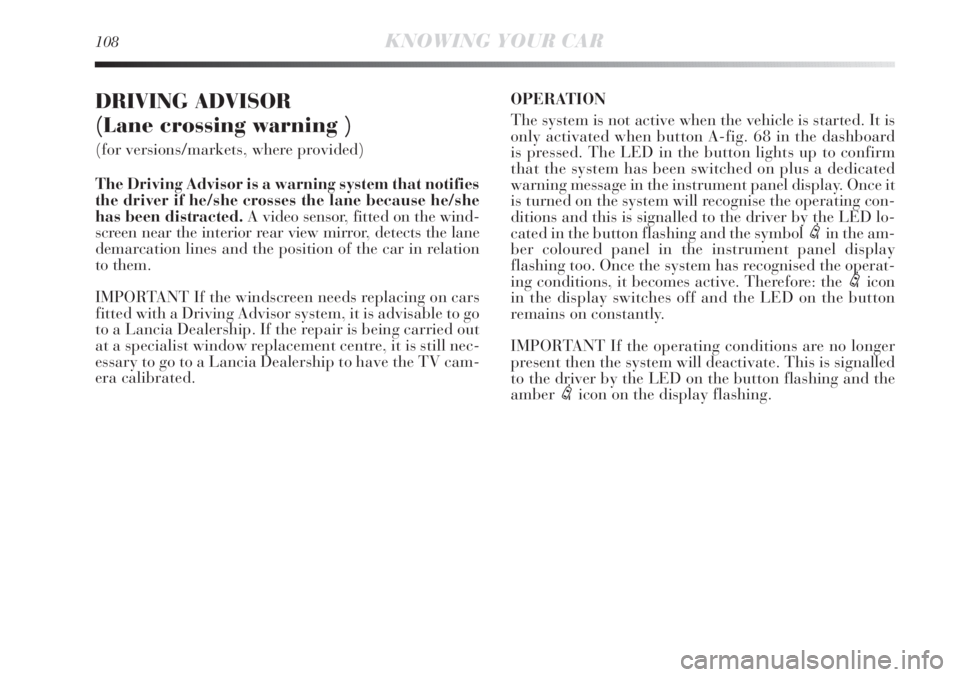
108KNOWING YOUR CAR
DRIVING ADVISOR
(Lane crossing warning )
(for versions/markets, where provided)
The Driving Advisor is a warning system that notifies
the driver if he/she crosses the lane because he/she
has been distracted.A video sensor, fitted on the wind-
screen near the interior rear view mirror, detects the lane
demarcation lines and the position of the car in relation
to them.
IMPORTANT If the windscreen needs replacing on cars
fitted with a Driving Advisor system, it is advisable to go
to a Lancia Dealership. If the repair is being carried out
at a specialist window replacement centre, it is still nec-
essary to go to a Lancia Dealership to have the TV cam-
era calibrated. OPERATION
The system is not active when the vehicle is started. It is
only activated when button A-fig. 68 in the dashboard
is pressed. The LED in the button lights up to confirm
that the system has been switched on plus a dedicated
warning message in the instrument panel display. Once it
is turned on the system will recognise the operating con-
ditions and this is signalled to the driver by the LED lo-
cated in the button flashing and the symbol
ein the am-
ber coloured panel in the instrument panel display
flashing too. Once the system has recognised the operat-
ing conditions, it becomes active. Therefore: the
eicon
in the display switches off and the LED on the button
remains on constantly.
IMPORTANT If the operating conditions are no longer
present then the system will deactivate. This is signalled
to the driver by the LED on the button flashing and the
amber
eicon on the display flashing.
Page 116 of 295

114KNOWING YOUR CAR
ADVANCED ESP SYSTEM
(ELECTRONIC STABILITY PROGRAM)
This is an electronic car stability control system in the
event of tyre grip loss, helping to maintain directional
control.
The Advanced ESP system is therefore particularly use-
ful when road surface grip conditions change.
With the Advanced ESP system as well as the ASR (trac-
tion control with intervention on the brakes and the en-
gine) plus the HILL HOLDER (device for hill starts with-
out using the brakes) and also MSR (adjustment of engine
braking force with gear downshift), HBA (automatic in-
crease in braking pressure during emergency braking),
ABS (preventing the wheels from locking and slipping on
all road surfaces during sharp braking and DST (appli-
cation of force on the steering wheel for steering correc-
tion) functions are all available. SYSTEM INTERVENTION
It is signalled by the blinking of the warning light á
on the instrument panel, to inform the driver that the car
is in critical stability and grip conditions.
Switching the system on
The Advanced ESP system comes on automatically when
the vehicle is started and cannot be turned off.
Failure indications
In the event of a failure, the Advanced ESP system will
be automatically switched off and warning light áwill
appear constantly in the instrument panel along with
a message on the reconfigurable multifunction display.
The LED on the ASR OFF button will also light up (see
“Instrument panel warning lights” chapter). In this case,
go to a Lancia Dealership.
The performance of the Advanced ESP sys-
tem should not encourage the driver to take
unnecessary risks. Your driving style must
always be suited to the road conditions, visibility
and traffic. The driver is ultimately responsible for
road safety.
Page 117 of 295
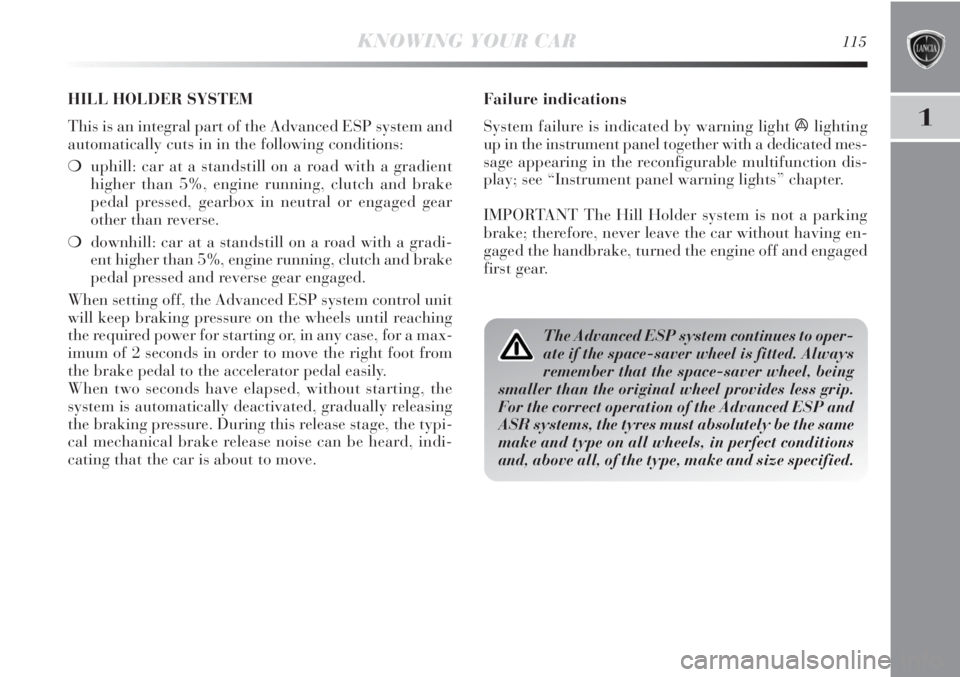
1
KNOWING YOUR CAR115
Failure indications
System failure is indicated by warning light
álighting
up in the instrument panel together with a dedicated mes-
sage appearing in the reconfigurable multifunction dis-
play; see “Instrument panel warning lights” chapter.
IMPORTANT The Hill Holder system is not a parking
brake; therefore, never leave the car without having en-
gaged the handbrake, turned the engine off and engaged
first gear.
The Advanced ESP system continues to oper-
ate if the space-saver wheel is fitted. Always
remember that the space-saver wheel, being
smaller than the original wheel provides less grip.
For the correct operation of the Advanced ESP and
ASR systems, the tyres must absolutely be the same
make and type on all wheels, in perfect conditions
and, above all, of the type, make and size specified.
HILL HOLDER SYSTEM
This is an integral part of the Advanced ESP system and
automatically cuts in in the following conditions:
❍uphill: car at a standstill on a road with a gradient
higher than 5%, engine running, clutch and brake
pedal pressed, gearbox in neutral or engaged gear
other than reverse.
❍downhill: car at a standstill on a road with a gradi-
ent higher than 5%, engine running, clutch and brake
pedal pressed and reverse gear engaged.
When setting off, the Advanced ESP system control unit
will keep braking pressure on the wheels until reaching
the required power for starting or, in any case, for a max-
imum of 2 seconds in order to move the right foot from
the brake pedal to the accelerator pedal easily.
When two seconds have elapsed, without starting, the
system is automatically deactivated, gradually releasing
the braking pressure. During this release stage, the typi-
cal mechanical brake release noise can be heard, indi-
cating that the car is about to move.
Page 122 of 295

120KNOWING YOUR CAR
EBD failure
This is signalled by the >andxwarning lights on the
instrument panel coming on, together with a message on
the reconfigurable multifunction display. In this case, the
rear wheels may suddenly lock and the vehicle may
swerve when braking sharply. Drive very carefully to the
nearest Lancia Dealership to have the system checked.
If only warning light xon the instrument
panel comes on, with a message in the re-
configurable multifunction display, stop the
car immediately and contact the nearest Lancia
Dealership. Leakage of hydraulic fluid from the
braking system will compromise the operation of
the braking system, whether it is of the conven-
tional type or with ABS.
FAILURE INDICATIONS
ABS failure
This is signalled by the >warning light in the instru-
ment panel coming on together with a message in the re-
configurable multifunction display. In this case, the brak-
ing system will still be effective, although without the
extra capacity offered by the ABS system. Drive carefully
to the nearest Lancia Dealership to have the system
checked.
Page 128 of 295
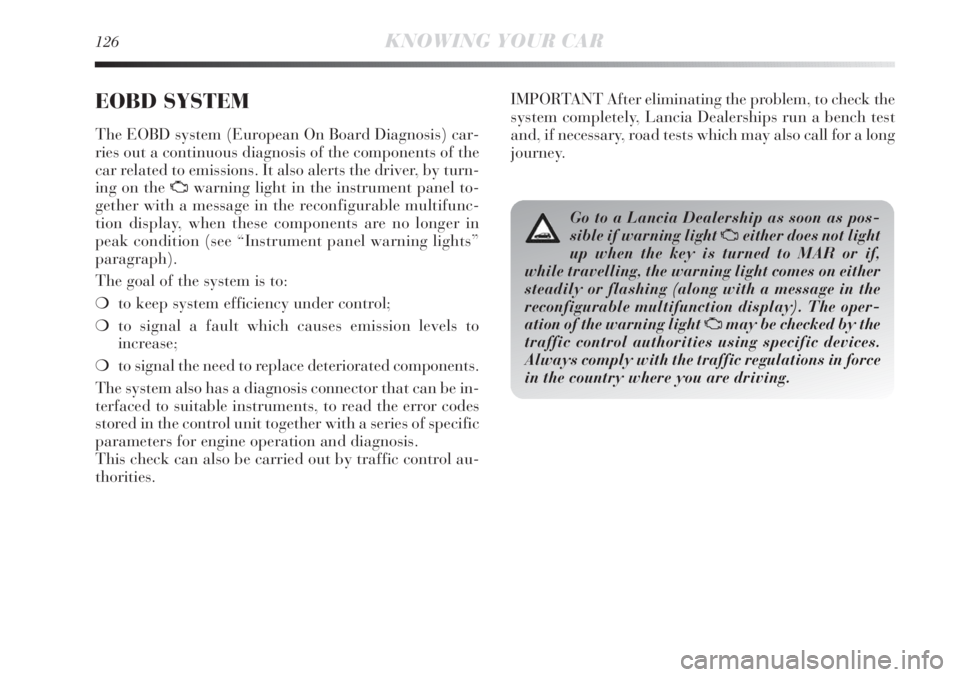
126KNOWING YOUR CAR
EOBD SYSTEM
The EOBD system (European On Board Diagnosis) car-
ries out a continuous diagnosis of the components of the
car related to emissions. It also alerts the driver, by turn-
ing on the
Uwarning light in the instrument panel to-
gether with a message in the reconfigurable multifunc-
tion display, when these components are no longer in
peak condition (see “Instrument panel warning lights”
paragraph).
The goal of the system is to:
❍to keep system efficiency under control;
❍to signal a fault which causes emission levels to
increase;
❍to signal the need to replace deteriorated components.
The system also has a diagnosis connector that can be in-
terfaced to suitable instruments, to read the error codes
stored in the control unit together with a series of specific
parameters for engine operation and diagnosis.
This check can also be carried out by traffic control au-
thorities.
Go to a Lancia Dealership as soon as pos-
sible if warning light
Ueither does not light
up when the key is turned to MAR or if,
while travelling, the warning light comes on either
steadily or flashing (along with a message in the
reconfigurable multifunction display). The oper-
ation of the warning light
Umay be checked by the
traffic control authorities using specific devices.
Always comply with the traffic regulations in force
in the country where you are driving.
IMPORTANT After eliminating the problem, to check the
system completely, Lancia Dealerships run a bench test
and, if necessary, road tests which may also call for a long
journey.
Page 139 of 295

1
KNOWING YOUR CAR137
SENSORS
While searching for a parking place, the system uses side
sensors (see fig. 81).
These sensors are automatically activated below around
30 km/h; during this stage if the driver has just passed
a space that might be useful for a manoeuvre, the func-
tion can be requested using the special button; at this
point the instructions for carrying out the manoeuvre will
be shown on the display. If the function is not requested
by the driver using the special button, no information will
be displayed on the instrument panel.OPERATION
The assisted parking manoeuvre can only be activated
with the instrument panel on and at speeds below about
30 km/h and is divided into the following stages:
❍Activation: pressing the button fig. 82 activates the
search stage.
❍Search: through side sensors, the system continuously
searches for a free parking space, suitable to the vehicle
dimensions. The driver determines on which side of the
road they intend to park using the direction indicators (if
no information is available from the direction indicators
or hazard warning lights, the search takes place on the
passenger side).
IMPORTANT The SEARCH stage in the system logic is
deactivated after about 10 mins if a suitable parking
space is not identified.
fig. 81L0E0296mfig. 82L0E0241m
Page 142 of 295

140KNOWING YOUR CAR
❍parking space longer than 130 cm compared to the
vehicle dimensions:parking in more than one manoeu-
vre, where only the first one can be carried out by auto-
matic steering management (the subsequent manoeuvres
are entirely the responsibility of the driver).
To select the search and manoeuvring side, the driver
must:
1)
DChoose to carry out the search for the space and the
manoeuvre on the passenger side with:
❍the direction indicator in the middle position;
❍the hazard warning lights on;
❍the hazard warning lights on and the direction indi-
cator in the passenger side position;
❍the direction indicator pointing towards the passen-
ger side.
2)
FChoose to carry out the search for the space and the
manoeuvre on the driver’s side with:
❍the direction indicator in the driver’s side position;
❍the hazard warning lights on and the direction indi-
cator in the driver side position;
The system will notify the driver, on the side in which the
search and the manoeuvre are taking place by means of
dedicated messages in the instrument panel display and
the symbol (
Fand
D) different on the right and left sides. The search will, however, take place on both sides, there-
fore it is possible to make the selection using the direc-
tion indicators even when having just driven past a park-
ing space that is deemed suitable.
During the search step, speed should not exceed 30 km/h;
when 25 km/h have been reached, the driver is asked to
decrease the speed; if the speed of 30 km/h is exceeded,
the system is disabled; in this case, the system must be
restarted by pressing the button A-fig. 82.
If the Lane crossing function is activated (see “Exterior
lights” paragraph) the search for the parking space al-
ways takes place on the passenger side.
If the parking sensors are activated during the search for
a parking space (see “Front and rear parking sensors”
paragraph), the operation of the Magic Parking system is
deactivated.
The search for the parking space and the
parking manoeuvres must be made in com-
pliance with the regulations in force of the
Highway Code.
Page 156 of 295
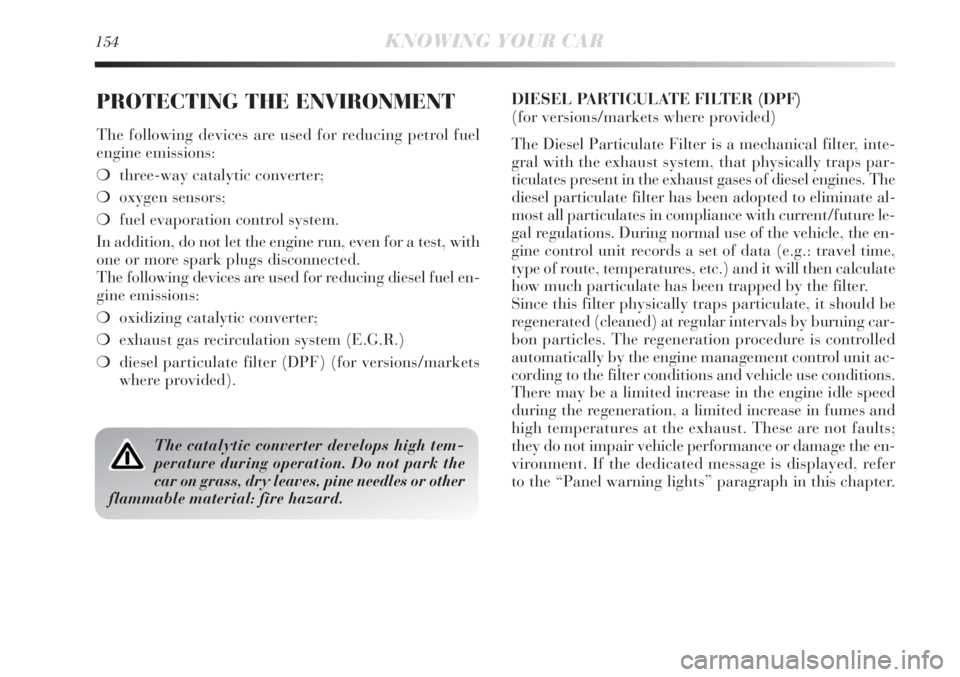
154KNOWING YOUR CAR
PROTECTING THE ENVIRONMENT
The following devices are used for reducing petrol fuel
engine emissions:
❍three-way catalytic converter;
❍oxygen sensors;
❍fuel evaporation control system.
In addition, do not let the engine run, even for a test, with
one or more spark plugs disconnected.
The following devices are used for reducing diesel fuel en-
gine emissions:
❍oxidizing catalytic converter;
❍exhaust gas recirculation system (E.G.R.)
❍diesel particulate filter (DPF) (for versions/markets
where provided).DIESEL PARTICULATE FILTER (DPF)
(for versions/markets where provided)
The Diesel Particulate Filter is a mechanical filter, inte-
gral with the exhaust system, that physically traps par-
ticulates present in the exhaust gases of diesel engines. The
diesel particulate filter has been adopted to eliminate al-
most all particulates in compliance with current/future le-
gal regulations. During normal use of the vehicle, the en-
gine control unit records a set of data (e.g.: travel time,
type of route, temperatures, etc.) and it will then calculate
how much particulate has been trapped by the filter.
Since this filter physically traps particulate, it should be
regenerated (cleaned) at regular intervals by burning car-
bon particles. The regeneration procedure is controlled
automatically by the engine management control unit ac-
cording to the filter conditions and vehicle use conditions.
There may be a limited increase in the engine idle speed
during the regeneration, a limited increase in fumes and
high temperatures at the exhaust. These are not faults;
they do not impair vehicle performance or damage the en-
vironment. If the dedicated message is displayed, refer
to the “Panel warning lights” paragraph in this chapter.
The catalytic converter develops high tem-
perature during operation. Do not park the
car on grass, dry leaves, pine needles or other
flammable material: fire hazard.